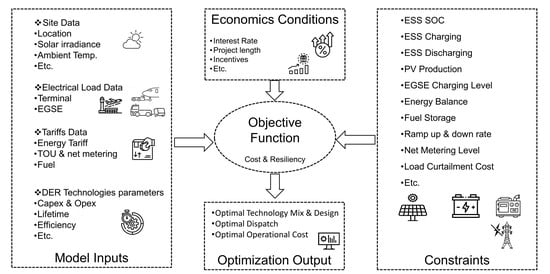Optimal Annual Operational Cost of a Hybrid Renewable-Based Microgrid to Increase the Power Resilience of a Critical Facility
Abstract
1. Introduction
1.1. Background
1.2. Literature Survey
1.3. Aim and Contributions
1.4. Paper Organization
2. Methodology and Optimization Formulation
2.1. Case Study
2.2. Optimization Formulation
2.3. Model Inputs
2.3.1. Load Profile
2.3.2. Solar Photovoltaic System
2.3.3. Battery Energy Storage System
2.3.4. Electric Ground Handling Equipment
3. Simulation Results
3.1. Scenario 1: Normal Operation (No Outages)
3.2. Scenario 2: Various Outages Criteria
3.2.1. Outages Starting Time
3.2.2. Critical Load Level
3.2.3. Outage Duration
3.3. Scenario 3: Solar PV Performance Changes
3.4. Scenario 4: Load Management Is Included
3.5. Analysis of the Results
4. Conclusions
Author Contributions
Funding
Data Availability Statement
Acknowledgments
Conflicts of Interest
Nomenclature
| Indices and Sets | |
| Set of months | |
| Set of day type, D = {peak, week, weekend} | |
| Set of hours | |
| Set of tariff demand period | |
| Set of diesel generators | |
| Set of renewable, K = {PV, Batteries} | |
| Set of all technologies, T = G K | |
| Set of demand priority, PR = {high critical, low critical, non-critical} | |
| Decision Variables | |
| Grid purchased energy | |
| Number of purchased diesel generators | |
| Capacity of purchased technologies of type k | |
| Energy provided by technology t | |
| Purchased fuel | |
| Exported energy by technology t | |
| Curtailed demand of level | |
| Energy demand | |
| Supplied energy to batteries | |
| Parameters | |
| Utility fixed monthly cost | |
| Utility energy tariff | |
| Number of days in month m | |
| Demand price | |
| Capacity of diesel generator | |
| Utility standby charge | |
| Annual O & M cost of generator | |
| Annual O & M cost of PV & ESS | |
| Capital cost per unit | |
| Annualized investment rate | |
| Fuel price | |
| Energy sellback price | |
| Price of curtailed energy | |
| Investment interest rate | |
| Technology lifetime | |
| Grid availability | |
| PV normalized performance | |
| PV capacity | |
| Storage capacity | |
| Charging and discharging rate | |
| Storage electricity input | |
| Storage electricity output | |
Appendix A. Simulated Model Inputs and Assumptions
| Site Characteristics | |
| Airport location | Santander, Cantabria, Spain |
| Latitude | 43.42283 |
| Longitude | −3.81866 |
| End-use profile | Electricity-Only, borrowed from [53] |
| Annual Usage | 3 GWh |
| Financial Parameters | |
| Interest Rate | 6% |
| Reporting Years | 25 |
| Incentives (storage and generators) | N/A |
| Electric GSE Charging Station Parameters | |
| Load shape | simulated |
| Rating | 154 kW |
| Efficiency | 96% |
| Total Available Charging Energy | 2536 kWh |
| Daily energy need | 2000 kWh |
| Solar PV System | |
| Purchase cost | 1600 USD/kWdc |
| O & M cost | 16 USD/kWdc/year |
| Lifetime | 25 years |
| Available space | 90,000 m2 |
| Panel Technology Type | standard |
| Array Type | Fixed ground-mounted |
| MACRS Incentives | 5 |
| Amount Depreciable | 100% |
| Efficiency | 15% |
| System Losses | 14% |
| Inverter Efficiency | 96% |
| Tilt Angle | 10 degrees |
| Pointing | South |
| source data | 5.2 km away (43.47, −3.81) |
| Energy Storage | |
| Purchase cost | 420 USD/kWh |
| Inverter cost | 840 USD/kW |
| O & M cost | 10 USD/kWh/year |
| Lifetime | 10 years |
| Max SOC | 100% |
| Min SOC | 20% |
| Emergency min SOC | 20% |
| Charging Efficiency | 96% |
| Continuous charging rate | 0.1 |
| Discharge Efficiency | 96% |
| Continuous discharging rate | 0.1 |
| Charge From Utility | allowed |
| MACRS Incentives | 7 years |
| Amount Depreciable | 100% |
| Diesel Generator | |
| Purchase cost | 500 USD/kW |
| O & M | 10 USD/kW/year |
| Lifetime | 15 |
| Efficiency | 30% |
| Fuel price | 0.8 USD/L |
| Fuel annual limit | 2500 L |
| Ramp up rate | 0.5 %/min |
| Ramp down rate | 0.5 %/min |
| Curtailment Cost—Scenario 4 | |
| High critical (30%) | 39.7 USD/kWh |
| Low critical (20%) | 12.7 USD/kWh |
| Non-critical (50%) | 1.3 USD/kWh |
References
- Moreno, R.; Trakas, D.N.; Jamieson, M.; Panteli, M.; Mancarella, P.; Strbac, G.; Marnay, C.; Hatziargyriou, N. Microgrids against Wildfires: Distributed Energy Resources Enhance System Resilience. IEEE Power Energy Mag. 2022, 20, 78–89. [Google Scholar] [CrossRef]
- Gholami, A.; Aminifar, F.; Shahidehpour, M. Front Lines Against the Darkness: Enhancing the Resilience of the Electricity Grid Through Microgrid Facilities. IEEE Electrif. Mag. 2016, 4, 18–24. [Google Scholar] [CrossRef]
- NREL. Distributed Solar PV for Electricity System Resiliency: Policy and Regulatory Considerations. Available online: https://www.nrel.gov/docs/fy15osti/62631.pdf (accessed on 16 January 2022).
- Kenward, A.; Raja, U. Blackout: Extreme Weather, Climate Change and Power Outages. Available online: http://assets.climatecentral.org/pdfs/PowerOutages.pdf (accessed on 21 February 2022).
- Hussain, A.; Bui, V.-H.; Kim, H.-M. Microgrids as a resilience resource and strategies used by microgrids for enhancing resilience. Appl. Energy 2019, 240, 56–72. [Google Scholar] [CrossRef]
- Amirioun, M.H.; Aminifar, F.; Lesani, H.; Shahidehpour, M. Metrics and quantitative framework for assessing microgrid resilience against windstorms. Int. J. Electr. Power Energy Syst. 2019, 104, 716–723. [Google Scholar] [CrossRef]
- Li, Z.; Shahidehpour, M.; Aminifar, F.; Alabdulwahab, A.; Al-Turki, Y. Networked Microgrids for Enhancing the Power System Resilience. Proc. IEEE 2017, 105, 1289–1310. [Google Scholar] [CrossRef]
- Kosai, S.; Cravioto, J. Resilience of standalone hybrid renewable energy systems: The role of storage capacity. Energy 2020, 196, 117133. [Google Scholar] [CrossRef]
- Hussain, A.; Bui, V.-H.; Kim, H.-M. Resilience-Oriented Optimal Operation of Networked Hybrid Microgrids. IEEE Trans. Smart Grid 2019, 10, 204–215. [Google Scholar] [CrossRef]
- Bie, Z.; Lin, Y.; Li, G.; Li, F. Battling the Extreme: A Study on the Power System Resilience. Proc. IEEE 2017, 105, 1253–1266. [Google Scholar] [CrossRef]
- Tan, S.; Wu, Y.; Xie, P.; Guerrero, J.M.; Vasquez, J.C.; Abusorrah, A. New Challenges in the Design of Microgrid Systems: Communication Networks, Cyberattacks, and Resilience. IEEE Electrif. Mag. 2020, 8, 98–106. [Google Scholar] [CrossRef]
- Anderson, K.H.; DiOrio, N.A.; Cutler, D.S.; Butt, R.S. Increasing Resiliency Through Renewable Energy Microgrids. Available online: https://www.osti.gov/biblio/1389210 (accessed on 16 January 2022).
- Younesi, A.; Shayeghi, H.; Siano, P.; Safari, A.; Alhelou, H.H. Enhancing the Resilience of Operational Microgrids Through a Two-Stage Scheduling Strategy Considering the Impact of Uncertainties. IEEE Access 2021, 9, 18454–18464. [Google Scholar] [CrossRef]
- Rosales-Asensio, E.; Simón-Martín, M.; Rosales, A.-E.; Colmenar-Santos, A. Solar-plus-storage benefits for end-users placed at radial and meshed grids: An economic and resiliency analysis. Int. J. Electr. Power Energy Syst. 2021, 128, 106675. [Google Scholar] [CrossRef]
- Kandaperumal, G.; Srivastava, A.K. Resilience of the electric distribution systems: Concepts, classification, assessment, challenges, and research needs. IET Smart Grid 2020, 3, 133–143. [Google Scholar] [CrossRef]
- Große, C. Airports as Critical Infrastructure: The Role of the Transportation-by-Air System for Regional Development and Crisis Management. In Proceedings of the 2019 IEEE International Conference on Industrial Engineering and Engineering Management (IEEM), Macao, China, 15–18 December 2019; pp. 440–444. [Google Scholar] [CrossRef]
- Ganji, M. Airport Microgrids: Transportation Energy as a Service. IEEE Electrif. Mag. 2020, 8, 121–124. [Google Scholar] [CrossRef]
- CNN. Atlanta’s Hartsfield-Jackson Airport Restores Power after Crippling Outage. Available online: https://edition.cnn.com/2017/12/17/us/atlanta-airport-power-outage/index (accessed on 11 January 2022).
- CNN Money. Delta’s Big Headache-Day 2. Available online: https://money.cnn.com/2016/08/09/news/companies/delta-flights-system-outage-delays-cancellations/index.html?iid=EL (accessed on 11 January 2022).
- CNN Money. Delta: 5-Hour Computer Outage Cost Us $150 Million. Available online: https://money.cnn.com/2016/09/07/technology/delta-computer-outage-cost (accessed on 11 January 2022).
- Panteli, M.; Mancarella, P.; Trakas, D.N.; Kyriakides, E.; Hatziargyriou, N.D. Metrics and Quantification of Operational and Infrastructure Resilience in Power Systems. IEEE Trans. Power Syst. 2017, 32, 4732–4742. [Google Scholar] [CrossRef]
- Mousavizadeh, S.; Haghifam, M.-R.; Shariatkhah, M.-H. A linear two-stage method for resiliency analysis in distribution systems considering renewable energy and demand response resources. Appl. Energy 2018, 211, 443–460. [Google Scholar] [CrossRef]
- Panteli, M.; Pickering, C.; Wilkinson, S.; Dawson, R.; Mancarella, P. Power System Resilience to Extreme Weather: Fragility Modeling, Probabilistic Impact Assessment, and Adaptation Measures. IEEE Trans. Power Syst. 2017, 32, 3747–3757. [Google Scholar] [CrossRef]
- Wang, Y.; Chen, C.; Wang, J.; Baldick, R. Research on Resilience of Power Systems Under Natural Disasters—A Review. IEEE Trans. Power Syst. 2016, 31, 1604–1613. [Google Scholar] [CrossRef]
- Sellberg, M.M.; Ryan, P.; Borgström, S.T.; Norström, A.V.; Peterson, G.D. From resilience thinking to Resilience Planning: Lessons from practice. J. Environ. Manage. 2018, 217, 906–918. [Google Scholar] [CrossRef]
- Najafi, J.; Peiravi, A.; Guerrero, J.M. Power distribution system improvement planning under hurricanes based on a new resilience index. Sustain. Cities Soc. 2018, 39, 592–604. [Google Scholar] [CrossRef]
- Zhao, Y.; Lin, Z.; Ding, Y.; Liu, Y.; Sun, L. Yan, Y. A Model Predictive Control Based Generator Start-Up Optimization Strategy for Restoration With Microgrids as Black-Start Resources. IEEE Trans. Power Syst. 2018, 33, 7189–7203. [Google Scholar] [CrossRef]
- Anderson, K.; Laws, N.D.; Marr, S.; Lisell, L.; Jimenez, T.; Case, T.; Li, X.; Lohmann, D.; Cutler, D. Quantifying and Monetizing Renewable Energy Resiliency. Sustainability 2018, 10, 933. [Google Scholar] [CrossRef]
- Masrur, H.; Sharifi, A.; Islam, M.R.; Hossain, M.A.; Senjyu, T. Optimal and economic operation of microgrids to leverage resilience benefits during grid outages. Int. J. Electr. Power Energy Syst. 2021, 132, 107137. [Google Scholar] [CrossRef]
- NY Solar Smart. Resilient Solar Photovoltaics (PV) Systems. Available online: https://nysolarmap.com/media/1451/dechardwarefactsheet.pdf (accessed on 12 January 2022).
- Princeton University. Microgrid|Facilities. Available online: https://facilities.princeton.edu/node/1486 (accessed on 12 January 2022).
- Elkadeem, M.R.; Wang, S.; Azmy, A.M.; Atiya, E.G.; Ullah, Z.; Sharshir, S.W. A systematic decision-making approach for planning and assessment of hybrid renewable energy-based microgrid with techno-economic optimization: A case study on an urban community in Egypt. Sustain. Cities Soc. 2020, 54, 102013. [Google Scholar] [CrossRef]
- Veilleux, G.; Potisat, T.; Pezim, D.; Ribback, C.; Ling, J.; Krysztofiński, A.; Ahmed, A.; Papenheim, J.; Pineda, A.M.; Sembian, S.; et al. Techno-economic analysis of microgrid projects for rural electrification: A systematic approach to the redesign of Koh Jik off-grid case study. Energy Sustain. Dev. 2020, 54, 1–13. [Google Scholar] [CrossRef]
- Nazemi, S.D.; Mahani, K.; Ghofrani, A.; Amini, M.; Kose, B.E.; Jafari, M.A. Techno-Economic Analysis and Optimization of a Microgrid Considering Demand-Side Management. In Proceedings of the 2020 IEEE Texas Power and Energy Conference (TPEC), College Station, TX, USA, 6–7 February 2020; pp. 1–6. [Google Scholar] [CrossRef]
- Nwulu, N.I.; Xia, X. Optimal dispatch for a microgrid incorporating renewables and demand response. Renew. Energy 2017, 101, 16–28. [Google Scholar] [CrossRef]
- Gamarra, C.; Guerrero, J.M. Computational optimization techniques applied to microgrids planning: A review. Renew. Sustain. Energy Rev. 2015, 48, 413–424. [Google Scholar] [CrossRef]
- Nelson, J.; Johnson, N.G.; Fahy, K.; Hansen, T.A. Statistical development of microgrid resilience during islanding operations. Appl. Energy 2020, 279, 115724. [Google Scholar] [CrossRef]
- Peterson, C.J.; Van Bossuyt, D.L.; Giachetti, R.E.; Oriti, G. Analyzing mission impact of military installations microgrid for resilience. Systems 2021, 9, 69. [Google Scholar] [CrossRef]
- Zhou, Q.; Shahidehpour, M.; Alabdulwahab, A.; Abusorrah, A.; Che, L.; Liu, X. Cross-Layer Distributed Control Strategy for Cyber Resilient Microgrids. IEEE Trans. Smart Grid 2021, 12, 3705–3717. [Google Scholar] [CrossRef]
- Zhou, L.; Chen, Z. Measuring the performance of airport resilience to severe weather events. Transp. Res. D Transp. Environ. 2020, 83, 102362. [Google Scholar] [CrossRef]
- Chan, R.; Schofer, J.L. Measuring Transportation System Resilience: Response of Rail Transit to Weather Disruptions. Nat. Hazards Rev. 2016, 17, 05015004. [Google Scholar] [CrossRef]
- Faturechi, R.; Levenberg, E.; Miller-Hooks, E. Evaluating and optimizing resilience of airport pavement networks. Comput. Oper. Res. 2014, 43, 335–348. [Google Scholar] [CrossRef]
- IEA. Spain-Countries & Regions-IEA. Available online: https://www.iea.org/countries/spain (accessed on 2 November 2021).
- Aena. Environmental Sustainability Report 2019. Available online: https://portal.aena.es/es/corporativa/informe-sostenibilidad-ambiental.html (accessed on 22 February 2022).
- Aena. Air Traffic Statistics. Available online: https://www.aena.es/es/estadisticas/inicio.html?_ga=2.196932394.721520391.1642376084-995102931.1629985337 (accessed on 16 January 2022).
- XENDEE. Microgrid Design and Decision Support Platform. Available online: https://xendee.com (accessed on 16 January 2022).
- XENDEE. US Army Garrison Bavaria Selects XENDEE for Design of Resilient Microgrids in Garmisch - XENDEE Microgrid Operating System Software. Available online: https://xendee.com/2019/12/18/us-army-garrison-bavaria/ (accessed on 16 January 2022).
- XENDEE. Recent Project Portfolio-XENDEE Microgrid Operating System Software. Available online: https://xendee.com/projects/ (accessed on 16 January 2022).
- Pecenak, Z.K.; Stadler, M.; Mathiesen, P.; Fahy, K.; Kleissl, J. Robust design of microgrids using a hybrid minimum investment optimization. Appl. Energy 2020, 276, 115400. [Google Scholar] [CrossRef]
- Pecenak, Z.K.; Stadler, M.; Fahy, K. Efficient multi-year economic energy planning in microgrids. Appl. Energy 2019, 255, 113771. [Google Scholar] [CrossRef]
- Schittekatte, T.; Stadler, M.; Cardoso, G.; Mashayekh, S.; Sankar, N. The impact of short-term stochastic variability in solar irradiance on optimal microgrid design. IEEE Trans. Smart Grid 2018, 9, 1647–1656. [Google Scholar] [CrossRef]
- Mashayekh, S.; Stadler, M.; Cardoso, G.; Heleno, M. A mixed integer linear programming approach for optimal DER portfolio, sizing, and placement in multi-energy microgrids. Appl. Energy 2017, 187, 154–168. [Google Scholar] [CrossRef]
- Ortega Alba, S.; Manana, M. Characterization and Analysis of Energy Demand Patterns in Airports. Energies 2017, 10, 119. [Google Scholar] [CrossRef]
- Endesa. Óptima Rate for Companies. Available online: https://www.endesa.com/en/companies/electricity/optimum-rate (accessed on 17 January 2022).
- Dobos, A.P. PVWatts Version 5 Manual. Available online: https://www.osti.gov/biblio/1158421 (accessed on 19 January 2022). [CrossRef]
- Tao, Y.-J.; Lee, H.-S.; Tu, C.-S. Analytic Hierarchy Process-Based Airport Ground Handling Equipment Purchase Decision Model. Sustainability 2021, 13, 2540. [Google Scholar] [CrossRef]
- NREL. Electric Ground Support Equipment at Airports. Available online: https://afdc.energy.gov/files/u/publication/egse_airports.pdf (accessed on 25 January 2022).
- EPRI & Southern Company. Electrification of an Airport Lower Deck Container Loader. Available online: https://www.epri.com/research/products/000000000001020484 (accessed on 19 January 2022).
- Trepel. Manufacturer of Cargo High Loaders and Aircraft Tractors. Available online: https://trepel.com/ (accessed on 19 January 2022).
- Aena. Seve Ballesteros-Santander. Available online: https://www.aena.es/en/seve-ballesteros-santander.html (accessed on 19 January 2022).
- Sullivan, M.; Collins, M.T.; Schellenberg, J.; Larsen, P.H. Estimating Power System Interruption Costs: A Guidebook for Electric Utilities. Available online: https://www.osti.gov/biblio/1462980 (accessed on 25 February 2022). [CrossRef]
- Baik, S.; Sanstad, A.H.; Hanus, N.; Eto, J.H.; Larsen, P.H. A hybrid approach to estimating the economic value of power system resilience. Electr. J. 2021, 34, 107013. [Google Scholar] [CrossRef]
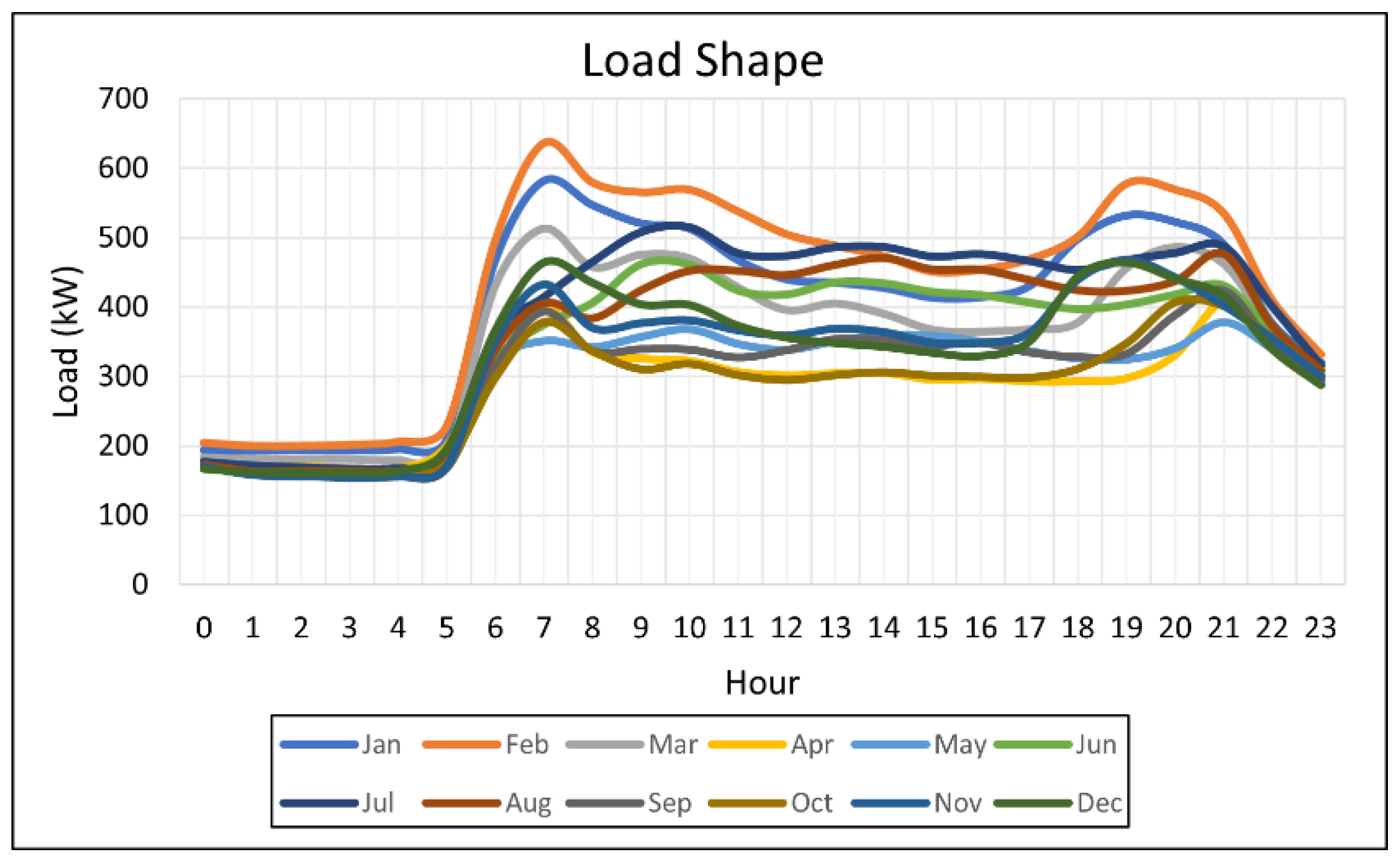


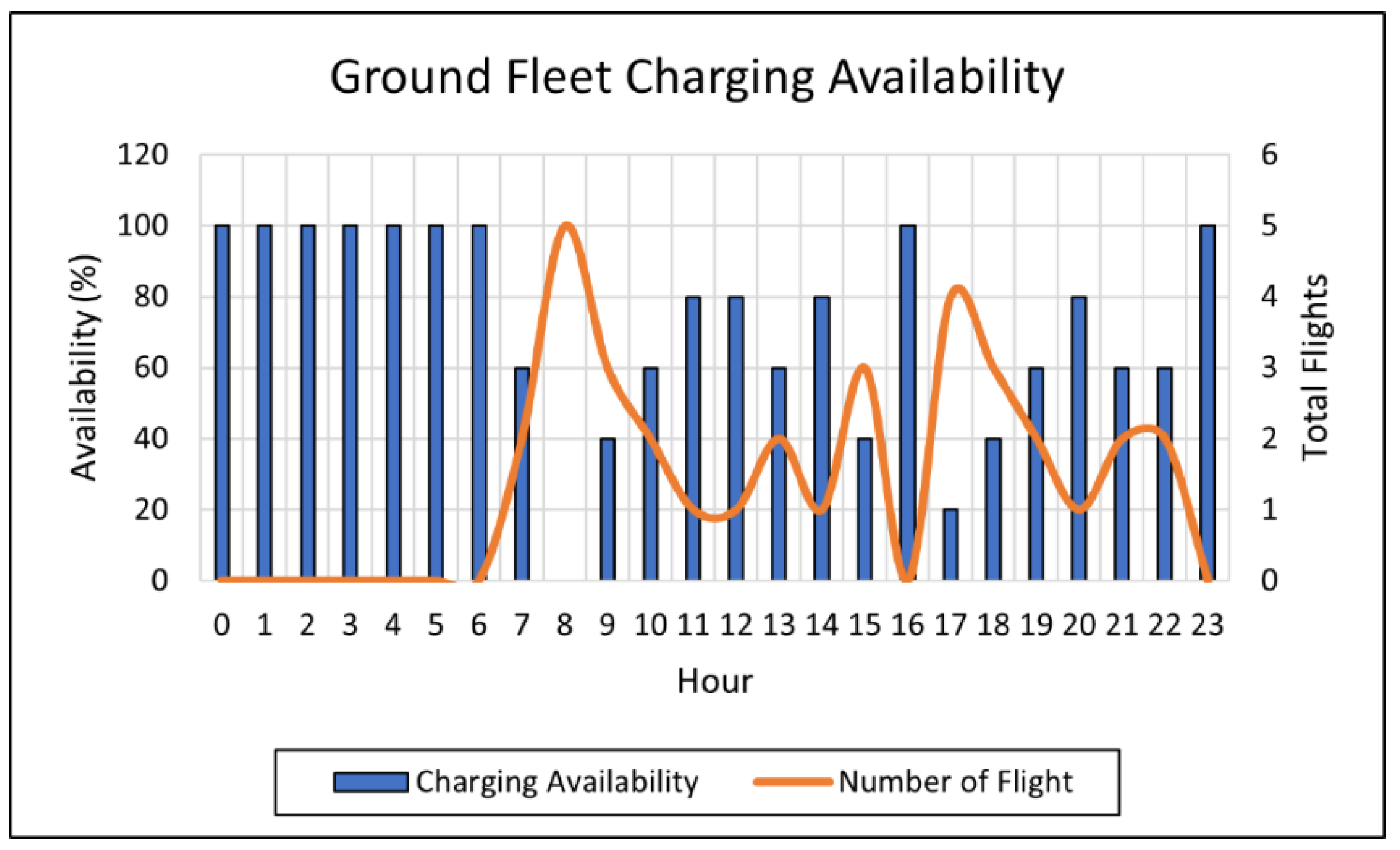
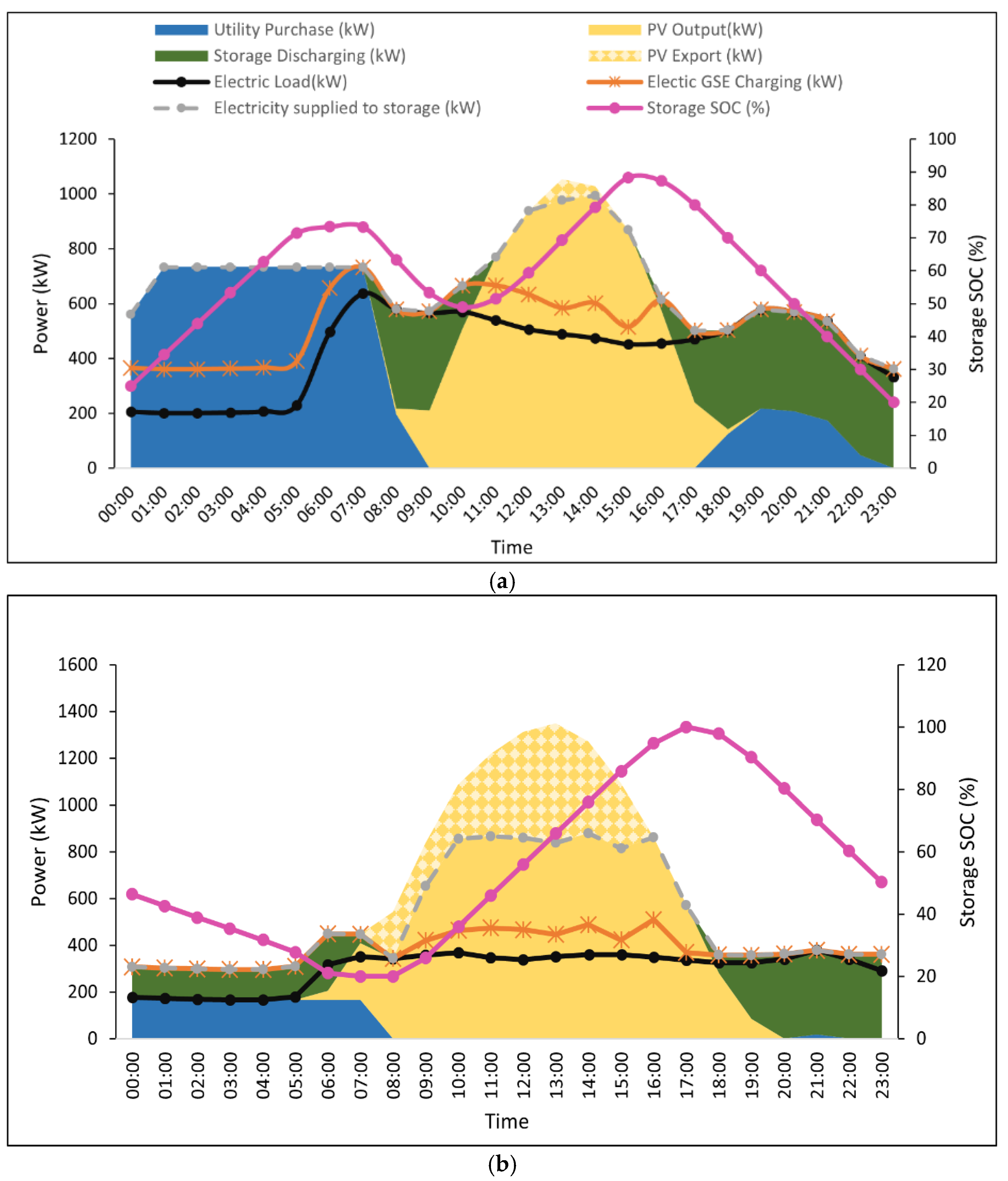
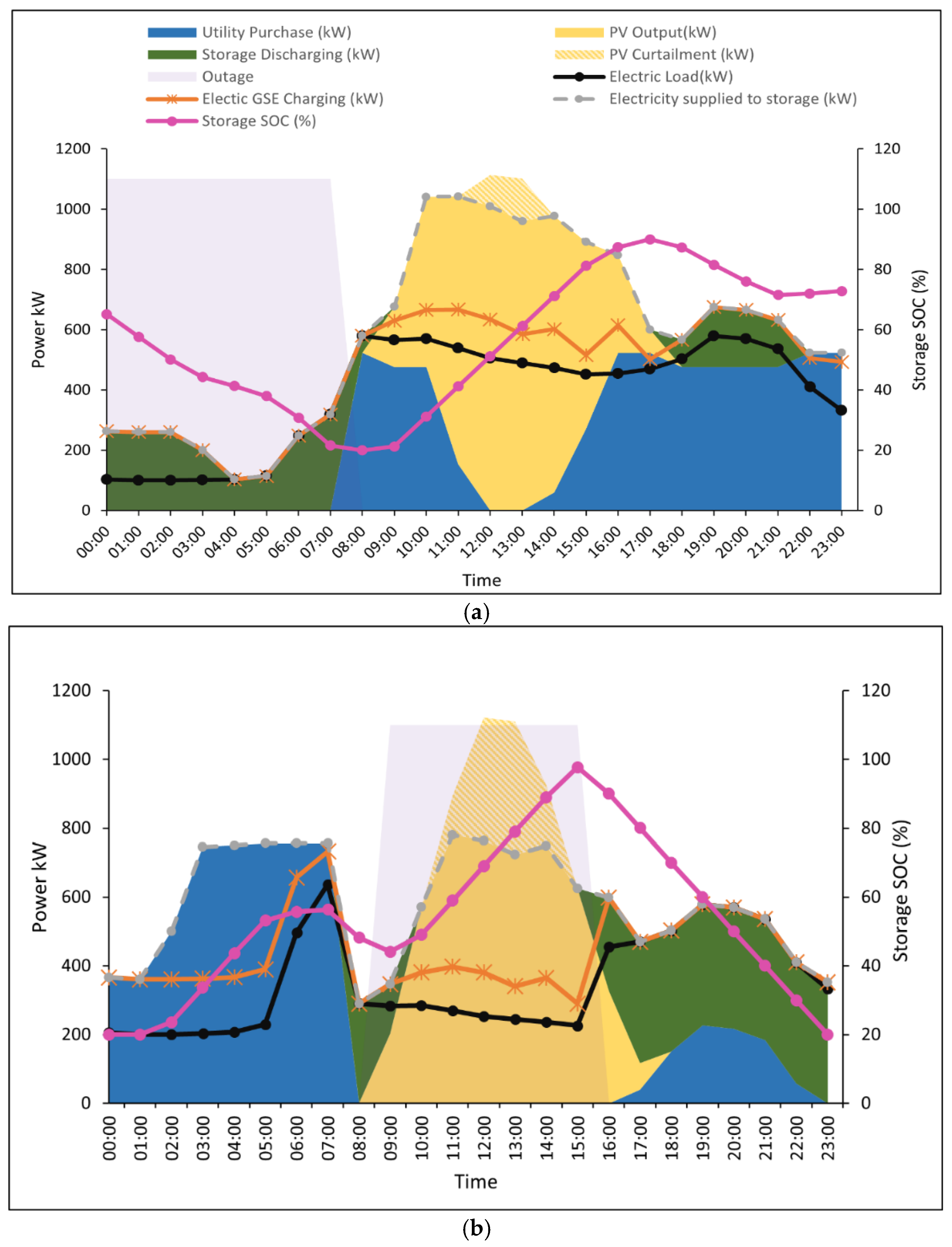

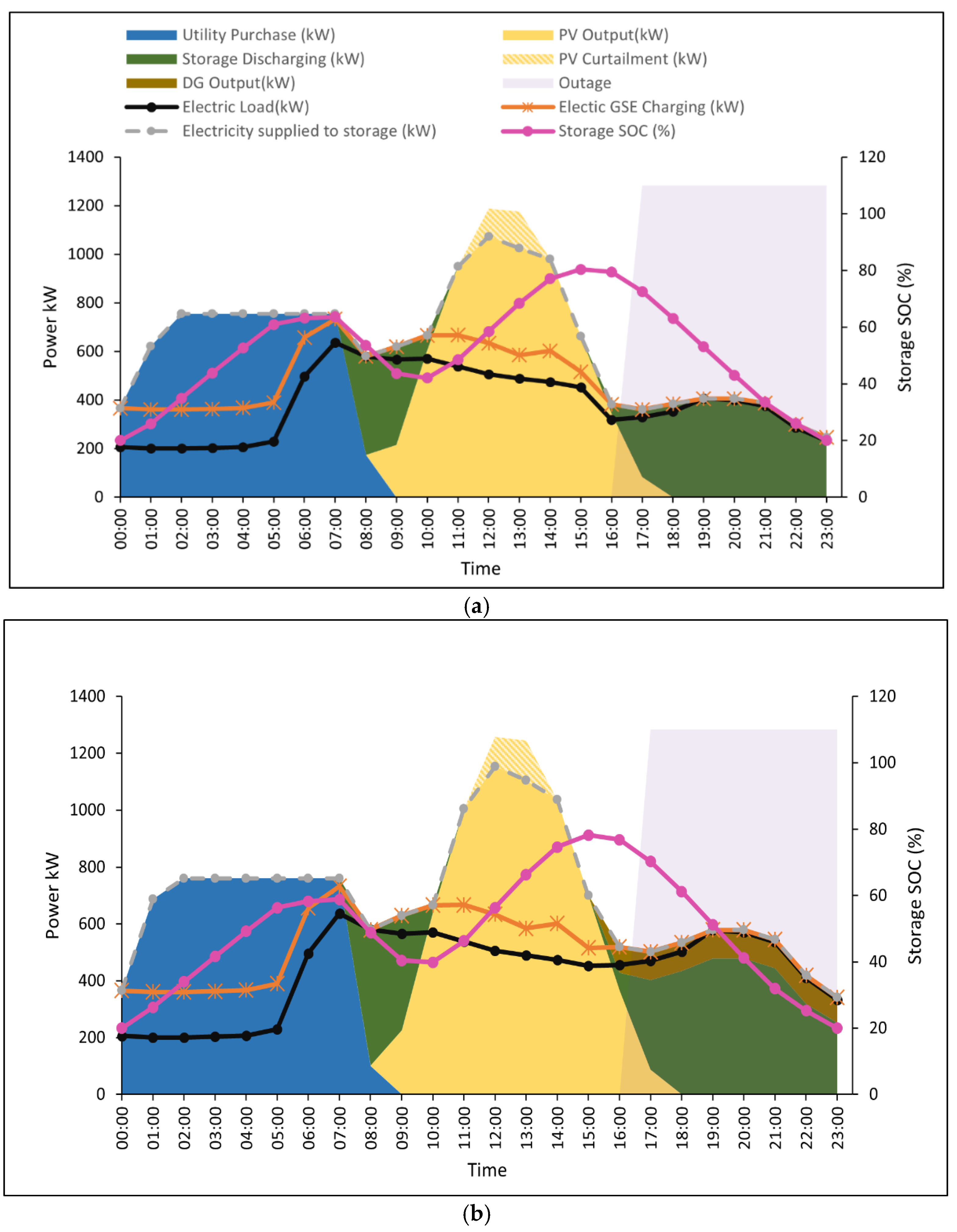
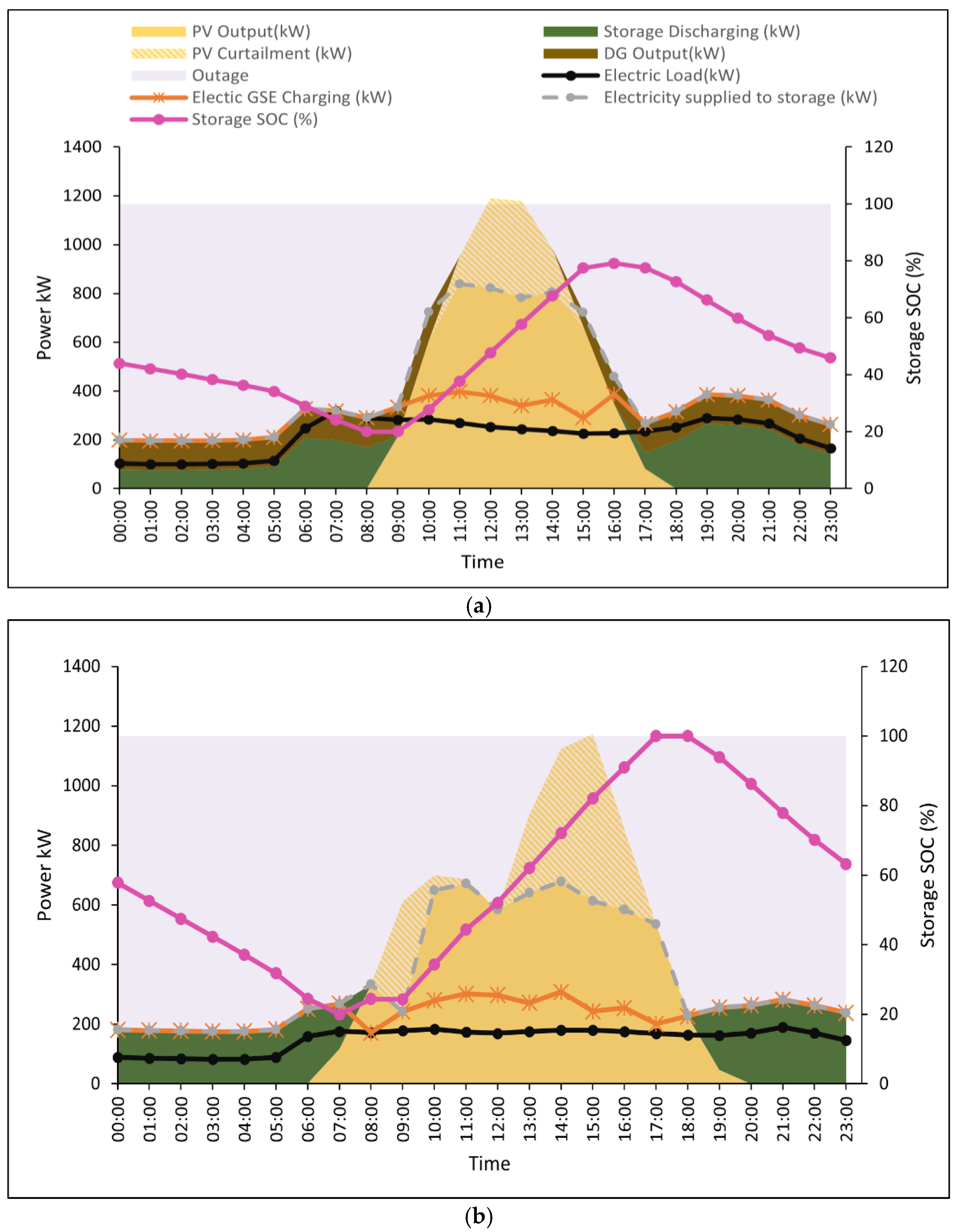
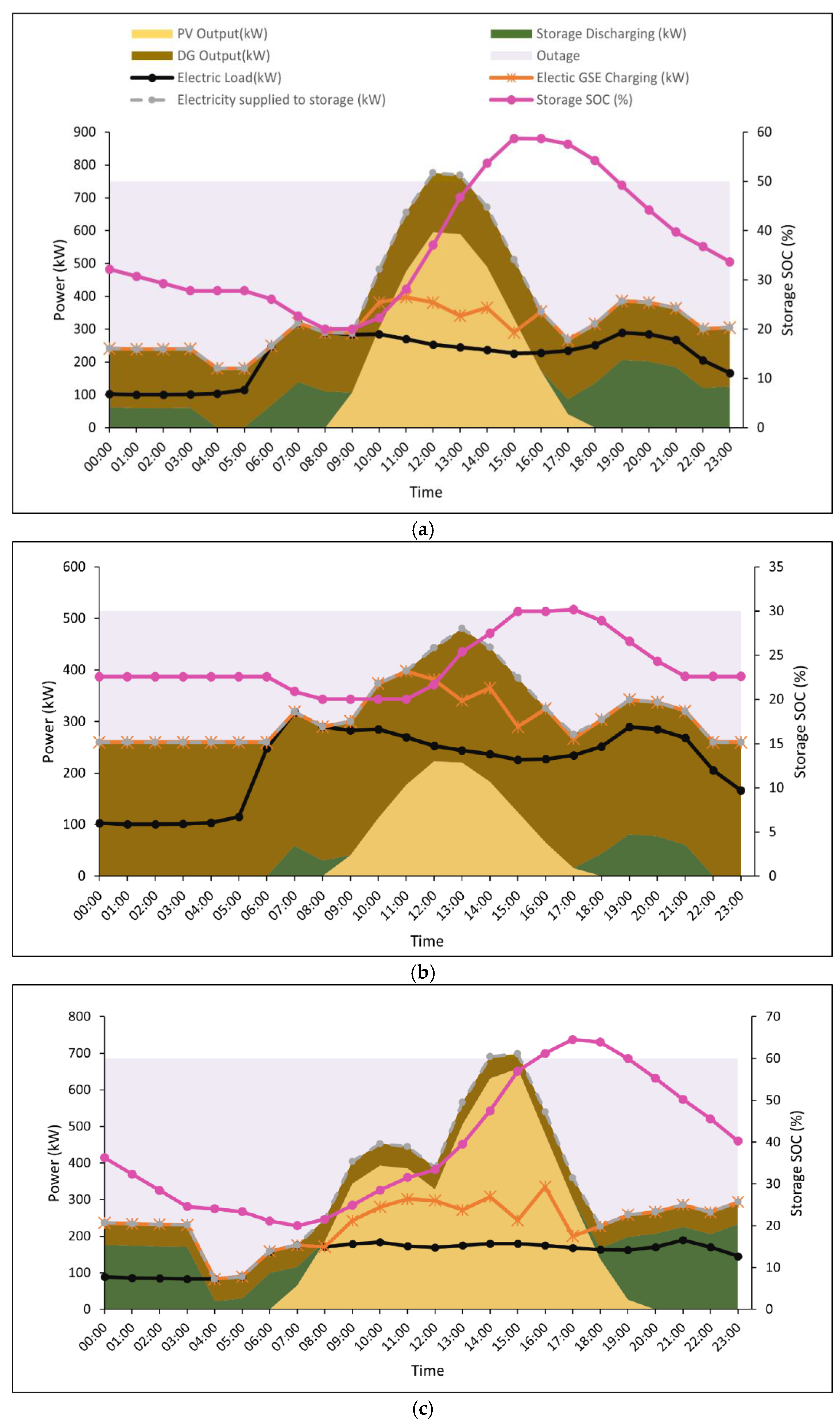
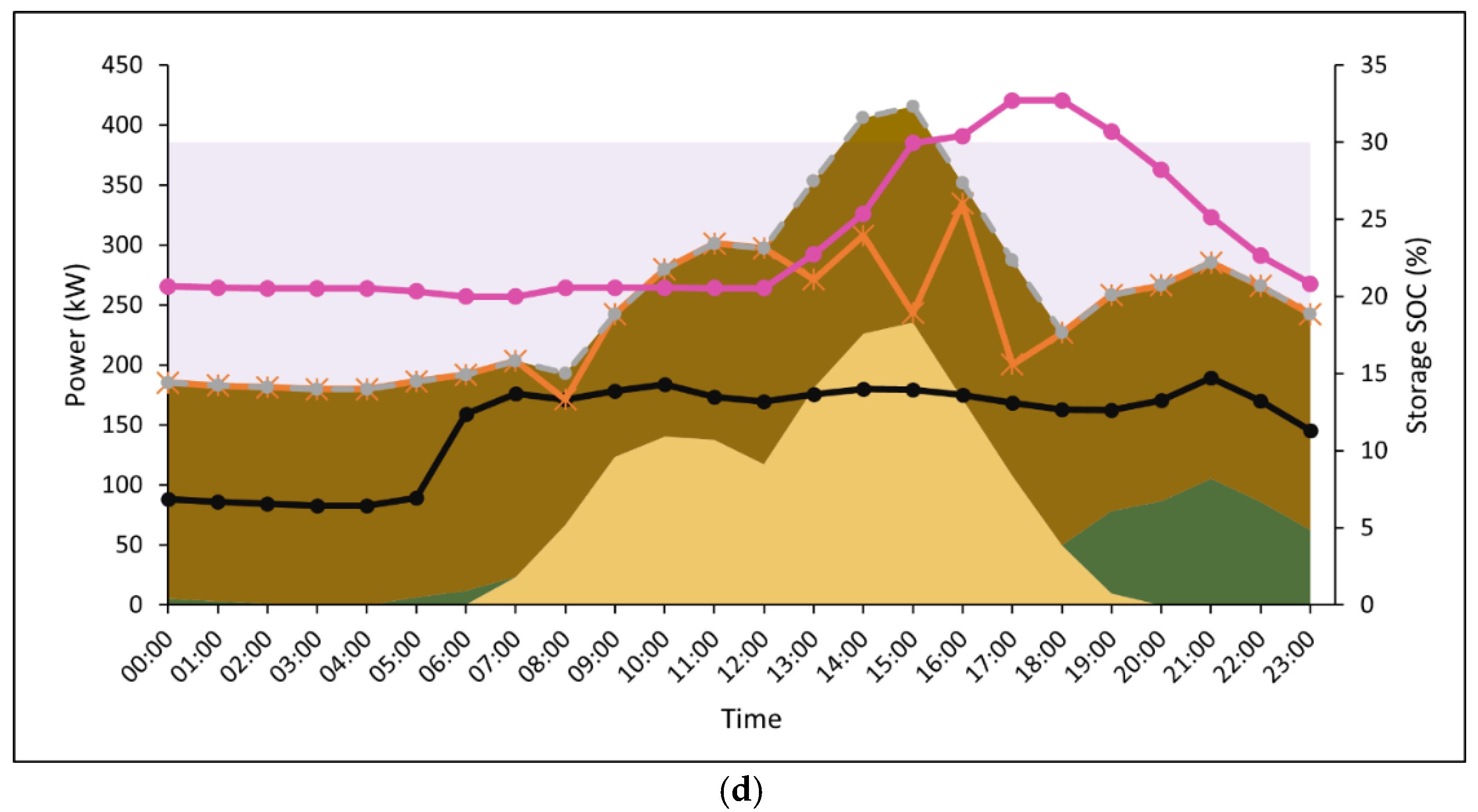
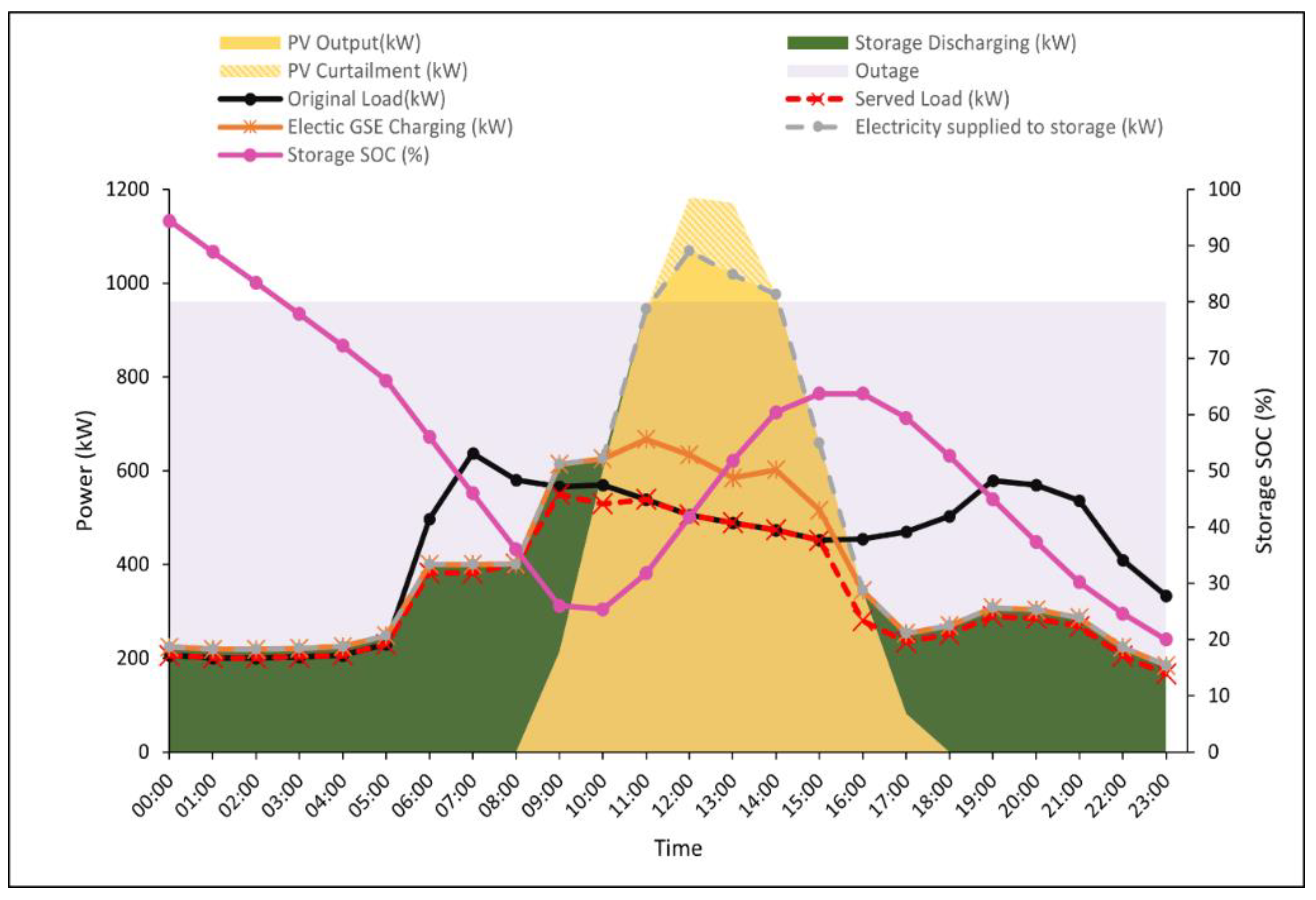
| February | ||||||||||||
|---|---|---|---|---|---|---|---|---|---|---|---|---|
| Critical Load Level | 50% | 70% | 100% | |||||||||
| Duration | Short | Long | Short | Long | Short | Long | ||||||
| Starting Time | T1 | T2 | T3 | T4 | T1 | T2 | T3 | T4 | T1 | T2 | T3 | T4 |
| PV (kW) | 2483 | 2502 | 2488 | 2654 | 2732 | 2649 | 2649 | 2681 | 2829 | 2834 | 2803 | 2739 |
| Batteries (kWh) | 3604 | 3675 | 3625 | 4246 | 4645 | 4219 | 4222 | 4347 | 5073 | 5093 | 4990 | 4520 |
| Diesel generators | 0 | 0 | 0 | 120 | 0 | 0 | 0 | 200 | 160 | 100 | 100 | 320 |
| BAU AOC (USD thousand) | 1383.3 | |||||||||||
| Optimized AOC (USD thousand) | 1080.9 | 1079.4 | 1079.1 | 1085.9 | 1083.3 | 1079.9 | 1079.8 | 1091.6 | 1094.9 | 1089.7 | 1089.2 | 1100.4 |
| Reduction (%) | 21.9 | 22.0 | 22 | 21.5 | 21.7 | 21.9 | 21.9 | 21.1 | 20.8 | 21.2 | 21.3 | 20.4 |
| May | ||||||||||||
| Critical Load Level | 50% | 70% | 100% | |||||||||
| Duration | Short | Long | Short | Long | Short | Long | ||||||
| Starting Time | T1 | T2 | T3 | T4 | T1 | T2 | T3 | T4 | T1 | T2 | T3 | T4 |
| PV (kW) | 2483 | 2483 | 2483 | 2577 | 2483 | 2483 | 2483 | 2574 | 2483 | 2483 | 2579 | 2700 |
| Batteries (kWh) | 3604 | 3604 | 3604 | 3885 | 3604 | 3604 | 3604 | 3885 | 3604 | 3604 | 3948 | 4383 |
| Diesel generators | 0 | 0 | 0 | 0 | 0 | 0 | 0 | 40 | 0 | 0 | 0 | 100 |
| BAU AOC (USD thousand) | 1383.3 | |||||||||||
| Optimized AOC (USD thousand) | 1080.9 | 1080.4 | 1080.4 | 1082.2 | 1081 | 1080.6 | 1080.6 | 1086.2 | 1081.3 | 1080.9 | 1081.1 | 1092.60 |
| Reduction (%) | 21.9 | 21.9 | 21.9 | 21.8 | 21.9 | 21.9 | 21.9 | 21.5 | 21.8 | 21.9 | 21.8 | 21 |
| February | May | |||||||
|---|---|---|---|---|---|---|---|---|
| Drop level | 30% | 50% | 80% | 100% | 30% | 50% | 80% | 100% |
| PV (kW) | 2726 | 2655 | 2483 | 2477 | 2576 | 2770 | 2480 | 2469 |
| Batteries (kWh) | 4475 | 4241 | 3604 | 3586 | 3937 | 4606 | 3596 | 3554 |
| Diesel generators | 140 | 180 | 260 | 320 | 20 | 60 | 180 | 240 |
| BAU AOC (USD thousand) | 1383.3 | |||||||
| Optimized AOC (USD thousand) | 1088.2 | 1090.2 | 1094.9 | 1098.90 | 1080.8 | 1085.7 | 1091.4 | 1095.5 |
| Reduction (%) | 21.3 | 21.2 | 20.9 | 20.6 | 21.9 | 21.5 | 21.1 | 20.8 |
Publisher’s Note: MDPI stays neutral with regard to jurisdictional claims in published maps and institutional affiliations. |
© 2022 by the authors. Licensee MDPI, Basel, Switzerland. This article is an open access article distributed under the terms and conditions of the Creative Commons Attribution (CC BY) license (https://creativecommons.org/licenses/by/4.0/).
Share and Cite
Alruwaili, M.; Cipcigan, L. Optimal Annual Operational Cost of a Hybrid Renewable-Based Microgrid to Increase the Power Resilience of a Critical Facility. Energies 2022, 15, 8040. https://doi.org/10.3390/en15218040
Alruwaili M, Cipcigan L. Optimal Annual Operational Cost of a Hybrid Renewable-Based Microgrid to Increase the Power Resilience of a Critical Facility. Energies. 2022; 15(21):8040. https://doi.org/10.3390/en15218040
Chicago/Turabian StyleAlruwaili, Mohammed, and Liana Cipcigan. 2022. "Optimal Annual Operational Cost of a Hybrid Renewable-Based Microgrid to Increase the Power Resilience of a Critical Facility" Energies 15, no. 21: 8040. https://doi.org/10.3390/en15218040
APA StyleAlruwaili, M., & Cipcigan, L. (2022). Optimal Annual Operational Cost of a Hybrid Renewable-Based Microgrid to Increase the Power Resilience of a Critical Facility. Energies, 15(21), 8040. https://doi.org/10.3390/en15218040





